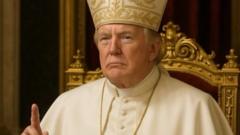In an effort to fulfill a campaign promise, Trump is considering an executive order that could initiate the closure of the Department of Education, an agency critical for overseeing public school funding, student loans, and programs benefiting disadvantaged students.
**Trump's Ambitious Plan to Dismantle the Department of Education: Is it Feasible?**

**Trump's Ambitious Plan to Dismantle the Department of Education: Is it Feasible?**
The potential dissolution of the Department of Education raises questions about its role and the challenges of such a significant change.
President Donald Trump is contemplating an executive order aimed at dismantling the U.S. Department of Education, an ambition long held by conservative factions and a promise he reiterated on his campaign trail. According to reports, Trump seeks to terminate numerous programs run by the agency while potentially redistributing others to different departments within the government. The directive is set to be communicated to newly confirmed Education Secretary Linda McMahon, urging her to pursue closure to the "maximum extent possible under the law," as outlined in a draft shared with the Wall Street Journal.
However, outright abolishment of the department cannot occur without a legislative act from Congress. Founded in 1979, the Department of Education is tasked with crucial roles: it manages public school funding, oversees student loans, and administers initiatives for low-income students. Accusations from Trump and his supporters point to the agency as a promoter of "indoctrinating content" concerning race and gender issues in education.
Despite some misconceptions that the Department dictates school curricula, educational authority primarily rests with state and local governments. The agency does allocate Pell grants aimed at supporting lower-income students and enforces civil rights statutes preventing discrimination in schools receiving federal assistance.
At a financial level, the department's budget for fiscal year 2024 stands at $238 billion, making up less than 2% of the total federal budget. The agency employs roughly 4,400 people, making it the smallest cabinet-level department in the federal government.
Realistically, Trump’s capacity to close the Department of Education is limited. He would require congressional backing, necessitating significant bipartisan support, including attaining a supermajority in the Senate, a feat not easily achievable given the current 53-47 Republican majority.
Previous attempts by Republicans to disband the department have faltered; a measure aimed at abolishing it failed in the House last year, with many party members siding against the proposal. Recently, the Trump administration has enacted reductions in other government sectors, underscoring a strategy to downsize the federal workforce, although legal challenges loom regarding some actions.
The push to eliminate the education agency traces back to historical Republican resistance against centralized education policy. Political figures like Ronald Reagan advocated for dismantling the department, arguing that education should be governed by states rather than a federal entity. Current critiques focus on what proponents label "woke" ideologies infiltrating education, while also advocating for increased school choice, allowing families to allocate public funds towards private or religious schooling alternatives.
In sum, while Trump’s administration may attempt to initiate shifts within the Department of Education, complete dissolution requires overcoming substantial political hurdles and legislative processes.





















